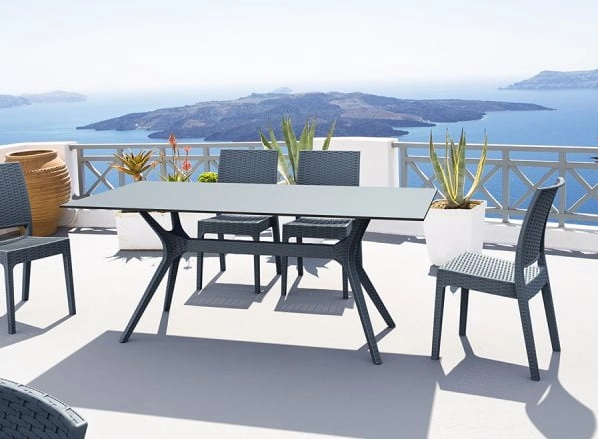High-Pressure Laminate (HPL), also known as Compact Laminate, has become one of the most versatile materials in modern construction and interior design. However, the quality differences between outdoor and indoor HPL compact laminate are significant — and understanding them is essential for ensuring long-term performance, aesthetics, and cost-effectiveness.
Both indoor and outdoor HPL share the same fundamental composition — multiple layers of kraft paper impregnated with phenolic resin, topped with decorative paper saturated with melamine resin, and compressed under high temperature and pressure. Yet, the difference lies in how they are engineered, treated, and optimized for their respective environments.

1. Weather Resistance: The Decisive Quality Factor
UV Resistance and Surface Durability
The most critical difference between outdoor and indoor HPL compact laminate lies in their UV and weather resistance.
Outdoor HPL panels are specifically designed to endure continuous exposure to sunlight, rain, and temperature fluctuations. During manufacturing, the outer decorative surface is enhanced with UV absorbers and light stabilizers. These additives prevent the board from fading, chalking, or cracking under prolonged UV exposure. Some high-performance outdoor laminates are also coated with acrylic resin or fluoropolymer coatings, forming a weatherproof barrier that resists photo-degradation.
Indoor HPL panels, in contrast, are not subjected to the same UV protection process. Since they are installed in controlled indoor environments, their decorative layer doesn’t require heavy UV stabilization. As a result, when indoor panels are mistakenly used outdoors, they fade rapidly and lose surface integrity under direct sunlight.
Resin Composition Optimization
To further reinforce outdoor HPL’s durability, manufacturers fine-tune the phenolic and melamine resin formulations. The phenolic resin core of outdoor panels is designed to resist temperature-induced expansion, moisture absorption, and chemical erosion from pollutants or acid rain. This optimization ensures that even in environments with drastic weather shifts — from scorching heat to freezing cold — the panels maintain their structure and color stability.
Indoor HPL boards, while using similar resins, are not engineered for such extremes. Their resin system focuses on aesthetic fidelity, ease of cleaning, and tactile comfort, rather than prolonged resistance to UV or moisture.
2. Structural Stability and Dimensional Balance
Outdoor Panels: Built for Environmental Extremes
Outdoor HPL compact laminate must maintain dimensional stability despite exposure to fluctuating temperature and humidity. These boards undergo precise density control during lamination, creating a compact structure that minimizes expansion and contraction.
To achieve this, the manufacturing process applies higher pressure and temperature to enhance molecular bonding between layers. The result is a panel that resists warping, delamination, and cracking, even when one side of the board is exposed to direct sunlight and the other remains shaded — a common condition for exterior wall cladding and outdoor furniture.
Indoor Panels: Optimized for Controlled Environments
Indoor HPL compact laminate, though moisture-resistant and structurally sound, is designed for stable interior conditions. Temperature and humidity levels indoors fluctuate minimally, allowing for a lighter density and a focus on design flexibility.
However, when indoor HPL is exposed to outdoor conditions, the imbalance of temperature and humidity between its surfaces can lead to warping and surface blistering. This is similar to the deformation caused by single-sided UV curing, where one side expands faster than the other due to heat absorption. Therefore, it is critical to select the appropriate grade of HPL based on the intended installation environment.

3. Surface Technology and Aesthetic Durability
Outdoor HPL: Functionality with Aesthetic Longevity
The surface of outdoor compact laminate undergoes special weather-resistant treatments. These may include dual-sided UV coatings, anti-graffiti finishes, and abrasion-resistant overlays. In architectural applications, these enhancements not only extend service life but also maintain vivid color and gloss retention over years of exposure.
Moreover, outdoor HPL panels often feature texture-engineered surfaces — such as wood grain, stone, or metallic finishes — created to mimic natural materials while providing superior resistance to fading and corrosion.
Indoor HPL: Design Flexibility and Sensory Appeal
Indoor compact laminates prioritize decorative versatility and tactile sensation. They can be finished with matte, high-gloss, or textured surfaces, depending on design intent. The primary objectives for indoor applications are aesthetic precision, scratch resistance, easy cleaning, and sometimes antibacterial performance — rather than outdoor weather endurance.
Common indoor applications include toilet partitions, cabinets, office furniture, laboratory countertops, and wall cladding. Because they are shielded from harsh sunlight and moisture, they retain their decorative appeal with minimal protective coating requirements.
4. Application Scenarios and Design Priorities
Outdoor HPL Applications
Outdoor-grade compact laminates are predominantly used in:
Building facades and exterior wall cladding
Outdoor furniture and benches
Public signage and billboards
Balcony panels and fencing systems
Their primary design priority is to deliver robustness, weather endurance, and long-term color stability, ensuring that installations maintain structural and aesthetic integrity even in demanding climates.
Indoor HPL Applications
Indoor laminates, in comparison, are widely utilized for:
Interior furniture and cabinetry
Restroom partitions
Kitchen and laboratory worktops
Interior wall panels and ceiling decorations
For these applications, visual appeal, surface smoothness, and resistance to abrasion and cleaning agents take precedence.

5. Manufacturing Process Distinctions
Pressure and Temperature Control
Outdoor compact laminates are manufactured under higher pressure and temperature conditions — typically over 9 MPa and 150°C — to achieve denser core compaction. This ensures exceptional mechanical strength and resistance to environmental stress.
Indoor laminates, while also high-pressure products, may undergo slightly lower compaction levels to allow greater surface flexibility and design adaptability, suitable for cutting, edging, and fabrication in interior settings.
Core Layer Treatment
Outdoor panels often include specially treated kraft layers with anti-fungal additives and enhanced moisture barriers, preventing biological degradation in humid outdoor climates. Indoor panels usually omit these treatments, focusing instead on color consistency and decorative alignment.
6. Cost and Performance Balance
Outdoor HPL compact laminates typically come at a higher price point, justified by their superior weather resistance, UV protection, and longevity. They are a long-term investment, minimizing maintenance costs over decades.
Indoor laminates, being more cost-effective, offer greater design flexibility for controlled environments without the need for heavy-duty weatherproofing. Both types have their distinct value, and selecting the right one ensures optimal performance and lifecycle efficiency.
Conclusion: Distinct Experts for Distinct Environments
The quality difference between outdoor and indoor HPL compact laminate lies not in superiority but in specialization.
Outdoor HPL is the weather-resistance expert — engineered to survive harsh climates, resist UV degradation, and maintain color stability.
Indoor HPL is the decorative performance expert — designed for beauty, tactile comfort, and adaptability in stable environments.
Using indoor panels outdoors leads to premature failure, while outdoor panels indoors may be unnecessary and uneconomical. The key to achieving both durability and cost-efficiency lies in selecting the right HPL for the right purpose.
English
Русский
العربية
Français
Español
Português
Deutsch
italiano
日本語
한국어
Nederlands
Tiếng Việt
ไทย
Polski
Türkçe
አማርኛ
Bahasa Melayu
தமிழ்
Filipino
Bahasa Indonesia
magyar
Română
Монгол
қазақ
Српски
हिन्दी
فارسی
Kiswahili
Slovenčina
Slovenščina
Svenska
українська
Ελληνικά
Suomi
Հայերեն
עברית
اردو
Shqip
বাংলা
Hrvatski
Afrikaans
Māori
සිංහල
Oʻzbekcha
latviešu
Беларуская мова
Bosanski
Български
ქართული
Lietuvių
Malti
Runasimi





